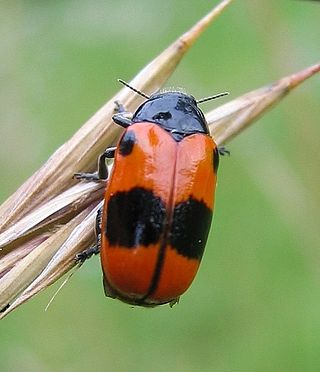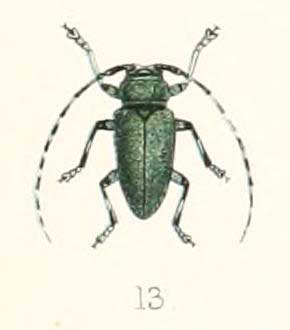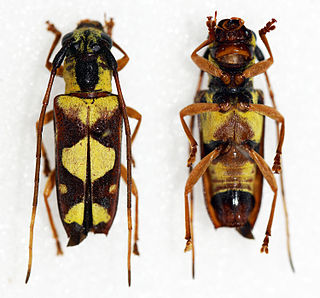Related Research Articles

The flea beetle is a small, jumping beetle of the leaf beetle family (Chrysomelidae), that makes up the tribe Alticini which is part of the subfamily Galerucinae. Historically the flea beetles were classified as their own subfamily.

The Clytrini are a tribe within the leaf beetle subfamily Cryptocephalinae, though historically they were often treated as a distinct subfamily, Clytrinae. As the other Cryptocephalinae, they belong to the group of case-bearing leaf beetles known as Camptosomata.

Endomychidae, or handsome fungus beetles, is a family of beetles with representatives found in all biogeographic realms. There are around 120 genera and 1300 species. The family was established based on the type genus Endomychus, a genus erected in 1795 by Panzer which was applied to a species that Linnaeus called Chrysomela coccinea. As the common name suggests, Endomychidae feed on fungi. Crowson, in his influential treatment of the beetles, placed the family within the Cucujoidea. They have a tarsal formal of 4-4-4 or 3-3-3 and the wings lack a closed radial cell. The second antennal segment has a sensory appendage that is as long as the third antennal segment. The family has also been grouped with the Coccinellidae in a group called the Trimera for having pseudotrimerous tarsi. A 2015 molecular phylogeny study found that the Cucujoidea were found to be non-monophyletic and the Endomychidae was refined with the removal of the Anamorphinae from within the family and elevated to the status of a full family, Anamorphidae. Mycetaeinae and Eupsilobiinae were also found not to belong within the clades of the core Endomychidae, and likewise reclassified into the families Mycetaeidae and Eupsilobiidae.

Puella Magi Madoka Magica, also known simply as Madoka Magica, is a Japanese anime television series created by Magica Quartet; and animated by Shaft. The story follows a group of middle school girls, led by protagonist Madoka Kaname, who make supernatural contracts to become magical girls. In battling surreal enemies known as "witches", they learn of the anguish and peril associated with their new roles. The first ten episodes of the series aired on TBS and MBS between January and March 2011, while the final two episodes were delayed until April of the same year due to the Tōhoku earthquake and tsunami.

Clytini is a tribe of beetles in the subfamily Cerambycinae, containing the following genera:
Trichrous is a genus of beetles in the family Cerambycidae, containing the following species:

Rhopalophora is a genus of beetles in the family Cerambycidae, containing the following species:

Saperdini is a tribe of longhorn beetles of the subfamily Lamiinae.

Glenea is a genus of longhorn beetles belonging to the family Cerambycidae, subfamily Lamiinae.

Ceroplesini is a tribe of longhorn beetles of the subfamily Lamiinae. It was described by Thomson in 1860.

Frea is a genus of longhorn beetles of the subfamily Lamiinae.

Leuconitocris is a genus of longhorn beetles of the subfamily Lamiinae, containing the following species:
Obereopsis is a genus of longhorn beetles of the subfamily Lamiinae, containing the following species:
Glenea extensa is a species of beetle in the family Cerambycidae. It was described by Francis Polkinghorne Pascoe in 1858. It is known from Borneo and Malaysia.

Glenea pulchella is a species of beetle in the family Cerambycidae. It was described by Francis Polkinghorne Pascoe in 1858. It is known from Java, Malaysia, Sumatra, Borneo, Moluccas, and the Philippines.
Glenea cyanipennis is a species of beetle in the family Cerambycidae. It was described by James Thomson in 1858.
Glenea flavicapilla is a species of beetle in the family Cerambycidae. It was described by Chevrolat in 1858. It is known from Gabon, the Ivory Coast, Cameroon, Ghana, and Kenya.

Glenea apicalis is a species of beetle in the family Cerambycidae. It was described by Chevrolat in 1857, originally under the genus Saperda. It has a wide distribution in Africa. It feeds on Hibiscus rosa-sinensis.
Glenea carneipes is a species of beetle in the family Cerambycidae. It was described by Louis Alexandre Auguste Chevrolat in 1855. It is known from Nigeria and the Democratic Republic of the Congo.
Glenea quinquelineata is a species of beetle in the family Cerambycidae. It was described by Louis Alexandre Auguste Chevrolat in 1855. It is known from Equatorial Guinea, Cameroon, the Democratic Republic of the Congo, the Ivory Coast, Uganda, Angola, and Nigeria.
References
- ↑ BioLib.cz - Glenea puella. Retrieved on 8 September 2014.